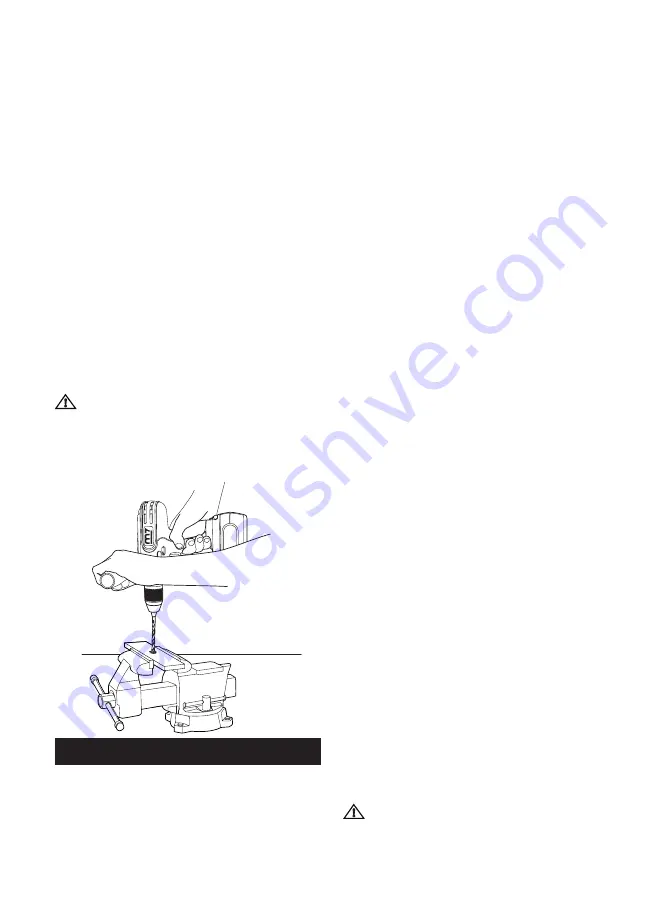
13
4) Depress the trigger switch to start the drill.
5) Move the drill bit into the workpiece, applying
only enough pressure to keep the bit cutting.
Do not force the drill or apply side pressure to
elongate a hole. Let the tool do the work.
6) When drilling hard, smooth surfaces, use a
center punch to mark the desired hole location.
This will prevent the drill bit from slipping off-
center as the hole is started.
7) When drilling metals, use a light oil on the
drill bit to keep it from overheating. The oil
will prolong the life of the bit and increase the
drilling action.
8) If the bit jams in the workpiece or if the drill
stalls, stop the tool immediately. Remove the bit
from the workpiece and determine the reason
for jamming.
NOTE:
This drill is equipped with an electric
brake. When the brake is functioning properly,
sparks may be visible through the vent slots in the
housing. This is normal and is the action of the
brake.
WARNING:
Be prepared for binding at bit
breakthrough. When these situations occur, the drill
has a tendency to grab and kick opposite to the
direction of rotation and could cause loss of control
when breaking through material. If not prepared,
this loss of control can result in possible serious
injury.
APPLICATION
WOOD DRILLING
For maximum performance, use high speed steel
or brad point bits for wood drilling.
1) Begin drilling at a very low speed to prevent the
bit from slipping off the starting point. Increase
speed as the drill bit bites into the material.
2) When drilling “through” holes, place a block
of wood behind the workpiece to prevent
ragged or splintered edges on the back side
of the hole.
METAL DRILLING
For maximum performance, use high speed
steel bits for metal or steel drilling.
1) When drilling metals, use a light oil on the
drill bit to keep it from overheating. The oil
will prolong the life of the bit and increase the
drilling action.
2) Begin drilling at a very low speed to prevent
the bit from slipping off the starting point.
3) Maintain a speed and pressure which allows
cutting without overheating the bit. Applying
too much pressure will:
- Overheat the drill.
- Wear the bearings.
- Bend or burn bits.
- Produce off-center or irregular-shaped holes.
MASONRY DRILLING
For maximum performance, use carbide-tipped
masonry bits when drilling holes in brick, tile,
concrete, etc.
1) Maintain a speed and pressure which allows
cutting without overheating the bit or drill.
Applying too much pressure will:
- Overheat the drill.
- Wear the bearings.
- Bend or burn bits.
- Produce off-center or irregular-shaped holes.
2) Apply light pressure and medium speed for
best results in brick.
3) Apply additional pressure for hard materials
such as concrete.
4) When drilling holes in tile, practice on a
scrap piece to determine the best speed and
pressure.
Begin drilling at a very low speed to prevent the
bit from slipping off the starting point.
WARNING: Always wear safety goggles
Summary of Contents for DD1813
Page 17: ...17...
Page 18: ...18 1 2 Chuck Cordless Drill ltem No DD18132A...
Page 20: ...20 1 2 Chuck Cordless Hammer Drill ltem No DH18262A...
Page 39: ...17...
Page 40: ...18 1 2 Chuck Cordless Drill ltem No DD1813...
Page 42: ...20 1 2 Chuck Cordless Hammer Drill ltem No DH1826...










































